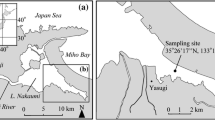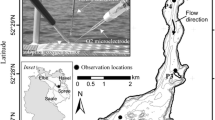Abstract
Dissolved oxygen concentrations in river-sediment porewaters are reported and modelled using a zero-order reaction rate and the Monod equation. After mixing the sediments and allowing settling, the dissolved oxygen profile in the bed-sediment was expected to reach a steady-state rapidly (< 1 h). However changes in the vertical profile of oxygen over a period of 38 days revealed that the penetration of oxygen increased and the dissolved oxygen flux at the interface decreased with time, probably as the oxidation kinetics of organic matter and redox reactions in the sediment changed. Experiments with three contrasting silt and sand dominated sediments (organic matter content between 0.9 and 18%) at two water velocities (ca 10 and 20 cm s−1) showed that the dissolved oxygen profiles were independent of velocity for each of the sediments. The most important controls on the reaction rate were the organic matter content and specific surface area of the sediment. A viscous diffuse-boundary-layer above the sediment was only detected in the experiments with the silt sediment where the sediment oxygen demand was relatively high. In the coarser sediments, the absence of a diffuse layer indicated that slow oxidation processes in the sediment controlled the dissolved oxygen flux at the interface. The problem of determining a surface reference in coarse sediment is highlighted. The results are discussed with reference to other studies including those concerned with estuarine and marine sediments.
Similar content being viewed by others
References
Allan I.J., House W.A., Warren N., Parker A. and Carter J.E. 2001. A Pilot Study of the Movement of Permethrin into Freshwater Sediments. Symposium Proceedings No. 78. British Crop Protection Council, Brighton, pp. 107–112.
Benson B.B. and Krause D. Jr 1980. The concentration and isotopic fractionation of gases dissolved in freshwater in equilibrium with the atmosphere. 1. Oxygen. Limnol. Ocean. 25: 662–671.
Barcelona M.J. 1983. Sediment oxygen demand fractionation, kinetics and reduced chemical substances. Water Res. 17: 1081–1093.
Berninger U.G. and Markus H. 1997. Impact of flow on oxygen dynamics in photosynthetically active sediments. Aquatic Microbial Ecology 12: 291–302.
Boudreau B.P. 1997. Diagenetic Models and Their Implementation. Springer-Verlang, New York.
Bouldin D.R. 1968. Models for describing the diffusion of oxygen and mobile constituents across the mud-water interface. J. Ecol. 56: 77–87.
Bowman G.T. and Delfino J.J. 1980. Sediment oxygen demand techniques: A review and comparison of laboratory and in situ systems. Water Res. 14: 491–499.
Cae W.-J. and Sayles F.L. 1996. Oxygen penetration depths and fluxes in marine sediments. Mar. Chem. 52: 123–131.
Chen G.-H., Leong I.-M., Liu J. and Huang J.-C. 1999. Study of the oxygen uptake by tidal river sediment. Wat. Res. 33: 2905–2912.
Edwards R.W. and Rolley H.L.J. 1965. Oxygen consumption of river muds. J. Ecology 53: 1–19.
Han P. and Bartels D.M. 1996. Temperature dependence of oxygen diffusion in H2O and D2O. J. Phys. Chem. 100: 5597–5602.
House W.A., Denison F.H., Smith J.T. and Armitage P.D. 1995. An investigation of the effects of water velocity on inorganic phosphorus influx to a sediment. Environmental Pollution 89: 263–273.
House W.A., Denison F.H., Warwick M.S. and Zhmud B.V. 2000. Dissolution of silica and the development of concentration profiles in freshwater sediments. Applied Geochemistry 15: 425–438.
Jorgensen B.B. and Marais D.J.D. 1990. The diffusive boundary layer of sediments: Oxygen microgradients over a microbial mat. Limnol. Oceanogr. 35: 1343–1355.
Jorgensen B.B. and Revsbech N.P. 1985. Diffusive boundary layers and the oxygen uptake of sediments and detritus. Limnol. Oceanogr. 30: 111–127.
Josiam R. and Stefan H. 1999. Effect of flow velocity on sediment oxygen demand: Comparison of theory and experiment. J. American Water Resources Assoc. 35: 433–439.
Jubb S., Guymer I., Licht G. and Prochnow J. 2001. Relating oxygen demand to flow: development of an in situ sediment oxygen demand measuring device. Water Sci. Technol. 43: 203–210.
Llanso R.J. 1992. Effects of hyoxia on estuarine benthos: the lower Rappahannock River (Chesapeake Bay), a case study. Estuarine Coastal Shelf Sci. 35: 491–515.
Mackenthun A.A. and Stefan H.G. 1998. Effect of flow velocity on sediment oxygen demand:experiments. J. Environ. Eng. 124: 222–230.
Martin P., Goddeeris B. and Martens K. 1993. Oxygen concentration profiles in soft sediment of Lake Baikal (Russia) near the Selenga delta. Freshwater Biol. 29: 343–349.
Nielson L.P., Christensen P.B., Revsbeck N.P. and Sorensen J. 1990. Dentrification and oxygen respiration in biofilms studied with a microsensor for nitrous oxide and oxygen. Microbial. Ecol. 19: 63–72.
Nriagu O.J. and Dell C.I. 1974. Diagenetic formation of iron phosphates in recent lake sediments. Amer. Mineral. 59: 934–946.
Pamatmat M.M. and Banse K. 1969. Oxygen consumption by the seabed. II In situ measurements to a depth of 180 m. Limnol. Ocean 14: 250–259.
Park S.S. and Jaffe P.R. 1999. A numerical model to estimate sediment oxygen levels and demand. J. Environ. Quality 28: 1219–1226.
Revsbech N.P., Sorensen J. and Blackburn T.H. 1980. Distribution of oxygen in marine sediments measured with microelectrodes. Limnol. Ocean 25: 403–411.
Seiki T., Izawa H., Date E. and Sunahara H. 1994. Sediment oxygen demand in Hiroshima Bay. Water Res. 28: 385–393.
Sincovec R.F. and Madsen N.K. 1975. Software for nonlinear partial differential equations. ACM Trans. Math. Software 1: 232–260.
Thirkette K.M. and Barrett K.L. 1994. Relationship between sediment handling techniques and emergence success for the midge Chironomus riparius. Proc. Brighton Crop Prot. Conf.-Pests and Diseases 3: 1331–1336.
Vink P.M. and Van der Zee S.E.A.T.M. 1977. Effect of oxygen status on pesticide transformation and sorption in undisturbed soil and lake sediments. Environ. Toxicol. Chem. 16: 608–616.
Wersin P., Hohener P., Giovanoli R. and Stumm W. 1991. Early diagenetic influences on iron transformations in a fresh-water lake sediment. Chem. Geol. 90: 233–252.
Woodruff S., House W.A., Callow M.E. and Leadbeater B.S.C. 1999. The effects of a developing bio-film on chemical changes across the sediment-water interface in a freshwater environment. Intern. Review of Hydrobiol. 84: 509–532.
Rights and permissions
About this article
Cite this article
House, W.A. Factors influencing the extent and development of the oxic zone in sediments. Biogeochemistry 63, 317–334 (2003). https://doi.org/10.1023/A:1023353318856
Issue Date:
DOI: https://doi.org/10.1023/A:1023353318856




